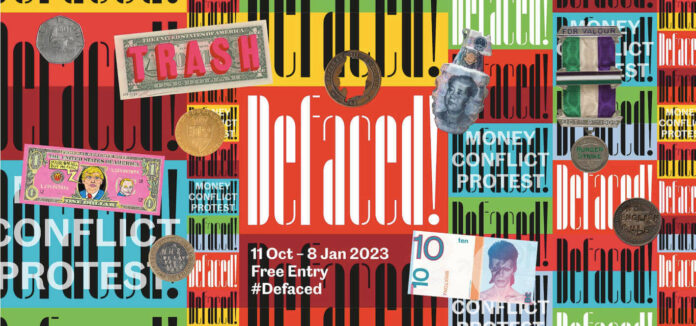Defaced! Money, Conflict, Protest (11 October-8 January 2023) is the first major exhibition to present a world history of protest through currencies that have been mutilated as cries of anger, injustice, or despair from the last 250 years. Defaced! showcases a new collection of defaced coins and banknotes recently acquired for the Fitzwilliam by its curator Dr Richard Kelleher, complemented by important loans from private collections and museums.

Punched, scratched, over-printed or digitally manipulated, there are many reasons people have decided to ‘take it out on money’. With their idealized portraits of leaders, emblems of national identity, and heavily policed production, currencies represent state authority in hand-held form. For artists and the individual alike, money’s iconic imagery makes it a potent readily available medium to address issues of social, political, and racial justice.
The acts of defacement on show reveal the hidden struggles behind some of the major events of the past 250 years, as disparate as the French and American Revolutions, the suffragette movement, the Siege of Mafeking, the Spanish Civil War, the Nazi concentration camp system and occupation, the deadly sectarian Troubles in Northern Ireland, and the Black Lives Matter protests.
In 1819, George Cruikshank made the Bank Restriction Note as a challenge to the draconian punishments meted out on those caught using, or even possessing, forged banknotes. Cruikshank altered the traditional iconography of the note, converting it into the images of state violence – skulls, a hangman’s noose, ships for transportation – penalties that were dealt to those who dared counterfeit paper money and disturb the fragile social promise upon which it was based.
Defaced currencies continued to condemn and question the establishment for the next 200 years. Engraved and mutilated coins throughout the exhibition rage at figures of power. George III, the Pope, and Prime Minister William Pitt all appear on the gallows, while other defacements are more satirical. George IV is converted into “the patron of vice and frivolity”, William IV is “the Idiot King”, and Queen Victoria has “shag for ever” engraved across her image.
From Thomas Spence’s call for the abolition of landlords, to the pennies laboriously defaced by the Suffragettes in the early 20th century, which saw the cry “Votes for Women” being circulated on currency itself, to the present-day campaign of stamped US $20 bills featuring the portrait of Harriet Tubman, money has been used to publicize campaigns for change and equality to the present day.
Money is the perfect medium to highlight issues of wealth distribution, including the chasm between those at the top and the bottom, and the effects on those living in poverty. It has been used by artists to draw attention to the links between government policy and the financial and banking systems.
A room devoted to the theme of poverty and wealth inequality forms a hinge-point to the exhibition with the spectacular loan of the fragments of an exploded transit van detonated by the HSCB (Hoe Street Central Bank) as part of the Big Bang 2 project which bought up £1.2m of payday loan debt in Walthamstow, London. Ben Oakley’s Jesus I’m Skint uses an icon-like religious figure in a pastiche of Roman Catholic kitsch.
For further information, visit the website of the Fitzwilliam Museum.
Read more about defacing in ancient roman coinage.
In recent years anti-semitic countermarks were found in circulation in Great Britain and the United States.

















